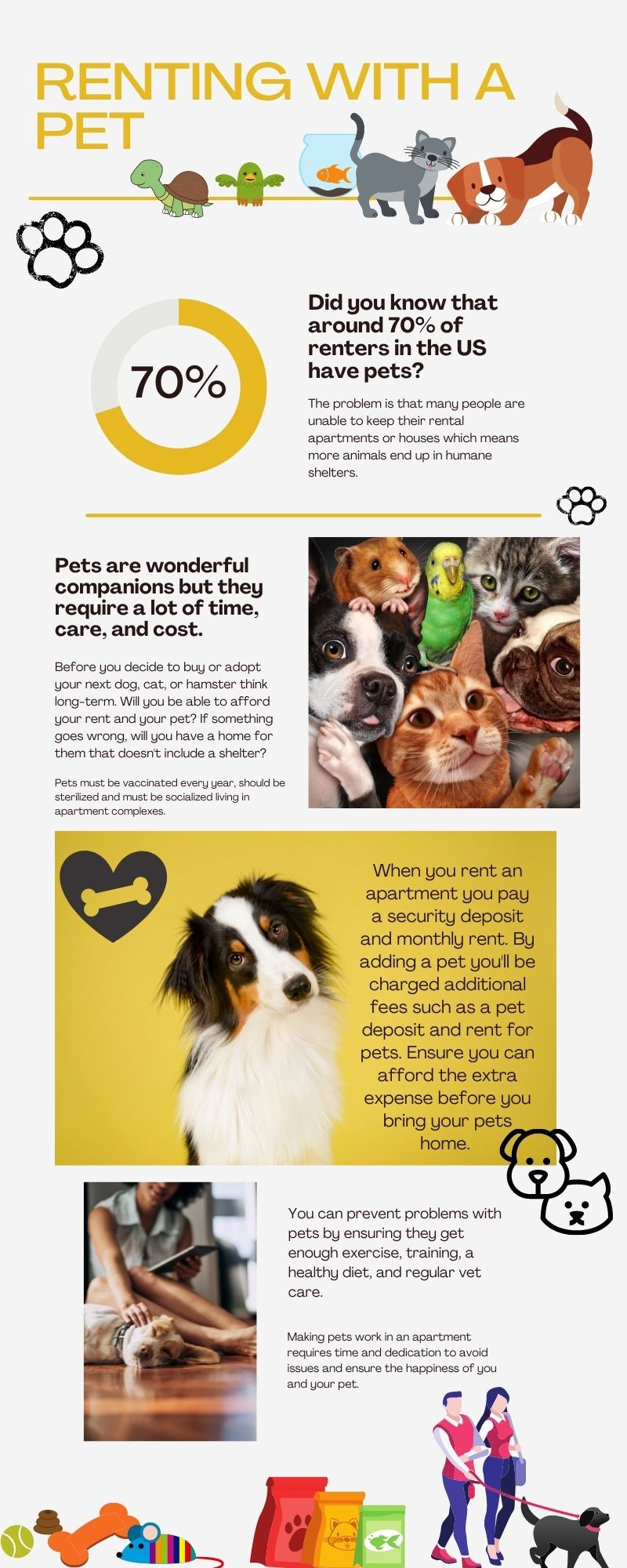Key Takeaways
Start socializing your pet early to ensure they adapt well to various environments and people.
A well-socialized pet can make finding pet-friendly rentals easier.
Expose your pet to different environments gradually to build their confidence.
Use positive reinforcement to encourage good behavior in your pet.
Creating a pet resume can help demonstrate your pet’s good behavior to potential landlords.
Why Socializing Your Pet Matters for Rentals
Finding a pet-friendly rental can be a challenging task. Landlords often worry about potential damages, noise complaints, or other issues that pets might bring. However, a well-socialized pet can significantly ease these concerns. When your pet is well-behaved and accustomed to various environments, it makes them more appealing to landlords. Therefore, investing time in socializing your pet can open more doors for you and your furry friend.
“Pet Companionship, Apartments & You” from www.apartmentsnearme.biz and used with no modifications.
Foundations of Pet Socialization
Ensuring your pet is well-socialized is crucial for a harmonious household. It’s important to introduce them to various environments and other animals gradually. For instance, understanding which plants are safe for your pets can also play a role in their comfort. Learn more about pet-safe plants like Angelonia to create a safe environment for them.
What is Pet Socialization?
Pet socialization involves exposing your pet to different environments, people, and experiences in a controlled manner. This helps them become comfortable and well-behaved in various situations. It’s not just about making your pet friendly; it’s about ensuring they can handle new experiences without stress or fear.
For example, taking your dog to a park where they can meet other dogs and people is a form of socialization. The goal is to make these encounters positive, so your pet learns to enjoy them rather than feel threatened.
Why Start Early?
Starting socialization early is crucial because young animals are more adaptable. Puppies and kittens, for instance, are naturally curious and more open to new experiences. Introducing them to different stimuli during this critical period helps them develop into well-rounded adults. Additionally, consider introducing them to safe plants like asters to make their environment more engaging.
Besides that, early socialization can prevent behavioral issues down the line. A pet that is comfortable around strangers, other animals, and various environments is less likely to exhibit fear-based aggression or anxiety.
Benefits of a Well-Socialized Pet
Improved behavior in public settings
Reduced anxiety and stress
Better adaptability to new environments
Increased chances of securing pet-friendly rentals
Enhanced quality of life for both pet and owner
When your pet is well-socialized, they’re not just easier to manage; they also enrich your life in countless ways. Imagine taking your dog to a café without worrying about them barking at strangers or your cat calmly adjusting to a new home without hiding for days. These are the real-life benefits of proper socialization.
Steps to Socialize Your Pet
Socializing your pet involves a series of steps that should be taken gradually. Rushing the process can overwhelm your pet and lead to negative experiences. Here’s a roadmap to get you started:
Expose your pet to different environments
Introduce your pet to various people
Use positive reinforcement methods
Address behavioral issues promptly
Exposing Your Pet to Different Environments
The first step in socializing your pet is to expose them to various environments. Start with familiar places and gradually introduce new settings. For example, begin with your backyard, then move on to a quiet park, and eventually, busier areas like city streets or pet-friendly stores.
When introducing new environments, keep these tips in mind:
Start slow and increase the complexity gradually.
Always ensure the environment is safe for your pet.
Watch for signs of stress and remove your pet if they seem overwhelmed.
Introducing Your Pet to Different People
Introducing your pet to different people is crucial for their socialization. For more tips on how to make this process smoother, check out these pet care resources.
Besides environments, your pet needs to get comfortable around different people. This includes men, women, children, and even people wearing hats or uniforms. Each new encounter helps your pet learn that people are friendly and not a threat. For more information on creating a safe environment for your pet, check out pet-safe plants.
Here’s how to do it:
Invite friends over to meet your pet in a controlled setting.
Take your pet to pet-friendly events or gatherings.
Encourage strangers to offer treats, creating a positive association.
Remember, the goal is to make each interaction a positive experience. If your pet shows signs of fear or aggression, take a step back and try again later.
Positive Reinforcement Methods
Positive reinforcement is one of the most effective ways to encourage good behavior in your pet. This method involves rewarding your pet for behaving well, which makes them more likely to repeat that behavior. Treats, praise, and petting are common forms of positive reinforcement. For instance, using pet-safe plants as a reward can also be a great idea.
Here’s how you can use positive reinforcement:
Give your pet a treat immediately after they display good behavior.
Use a consistent command or signal to mark the desired behavior.
Gradually phase out treats and rely more on praise as your pet learns.
For example, if your dog sits calmly when meeting a new person, give them a treat and say, “Good sit!” This reinforces the idea that sitting calmly is a good thing.
Addressing Behavioral Issues
Even with the best socialization efforts, your pet may develop some behavioral issues. It’s essential to address these issues promptly to prevent them from becoming ingrained habits. Common issues include fear, aggression, and anxiety.
Here are some steps to address behavioral issues: If your pet’s behavior is related to their environment, consider incorporating pet-safe evergreen shrubs that can withstand dog urine in your garden.
Identify the root cause of the behavior.
Consult with a veterinarian or a professional trainer.
Use positive reinforcement to encourage alternative behaviors.
Be patient and consistent in your training efforts.
For instance, if your dog shows aggression towards other dogs, try to understand why. Are they fearful? Territorial? Once you identify the cause, you can work on desensitizing them to other dogs in a controlled manner.
Managing Your Pet in a Rental Home
Creating a pet-friendly environment
Maintaining a routine and exercise schedule
Implementing cleaning and maintenance tips
Managing your pet in a rental home involves more than just keeping them well-behaved. You need to create an environment that is safe and comfortable for them while also being mindful of the property.
Creating a Pet-Friendly Environment
Creating a pet-friendly environment in your rental home can make a big difference in your pet’s behavior and well-being. Start by designating specific areas for your pet to eat, sleep, and play. This helps establish boundaries and makes it easier to keep the home clean.
Consider the following tips:
Use pet gates to restrict access to certain areas.
Provide plenty of toys and activities to keep your pet engaged.
Ensure your pet has a comfortable bed and a designated feeding area.
For example, setting up a cozy corner with your dog’s bed and favorite toys can make them feel more secure and less likely to cause trouble elsewhere in the house. You can also consider adding pet-safe plants to create a more inviting environment for your pet.
Routine and Exercise
A consistent routine and regular exercise are crucial for a well-behaved pet. Pets thrive on predictability, and a routine helps reduce anxiety and behavioral issues. Make sure your pet gets enough physical and mental stimulation to keep them happy and healthy.
Here’s how to maintain a routine:
Feed your pet at the same times each day.
Set aside specific times for walks and play.
Incorporate training sessions into your daily routine.
For instance, taking your dog for a morning walk before you leave for work can help burn off excess energy and reduce the likelihood of destructive behavior while you’re away.
Cleaning and Maintenance Tips
Keeping your rental home clean is essential, especially when you have pets. Regular cleaning helps prevent odors and damage, making it easier to maintain a good relationship with your landlord.
Here are some cleaning tips:
Vacuum regularly to remove pet hair and dander.
Use pet-safe cleaning products to avoid harmful chemicals.
Clean your pet’s bedding and toys frequently.
Address accidents immediately to prevent stains and odors.
For example, investing in a good vacuum cleaner designed for pet hair can make a significant difference in keeping your home clean and free of allergens.
Tips for Finding Pet-Friendly Rentals
When searching for a new home, it’s essential to consider your pets. Many landlords have strict policies regarding pets, so it’s crucial to find rentals that accommodate your furry friends. For example, some plants like Sweet Alyssum are safe for pets and can make your new place feel more like home.
Finding a pet-friendly rental can be a daunting task, but with the right approach, you can increase your chances of success. Here are some tips to help you find a rental that welcomes both you and your pet:
Research pet policies
Create a pet resume
Seek recommendations
Meet landlords with your pet
Researching Pet Policies
When looking for a new place to live, it’s crucial to research pet policies to ensure your furry friend is welcome. Understanding the rules and regulations regarding pets can save you time and prevent potential issues with landlords.
Before you start your search, it’s essential to understand the pet policies of potential rentals. Some landlords have strict rules about the types of pets allowed, while others may require additional deposits or fees.
Here’s what to look for:
Check if there are breed or size restrictions.
Inquire about pet deposits and monthly fees.
Ask about any specific rules regarding pets in common areas.
For example, some rentals may allow cats but not dogs, or they may have a weight limit for dogs. Knowing these details upfront can save you time and effort.
Creating a Pet Resume
When creating a pet resume, it’s important to highlight your pet’s best qualities and any training they have undergone. This can include obedience classes, socialization skills, and any other relevant information that showcases your pet as a well-behaved companion. For instance, if your pet is well-behaved around plants, you might want to mention their familiarity with pet-friendly plants.
A pet resume can be a valuable tool in your search for a pet-friendly rental. It provides potential landlords with information about your pet’s behavior, health, and training, helping to alleviate any concerns they may have. Additionally, knowing which plants are safe for pets can also be beneficial when discussing pet safety with landlords.
Include the following in your pet resume:
A recent photo of your pet
Details about your pet’s breed, age, and weight
Information about vaccinations and health status
Notes on your pet’s temperament and training
References from your current landlord or veterinarian
For example, a well-crafted pet resume might include a statement like, “Buddy is a 5-year-old Labrador Retriever who is up-to-date on all vaccinations, has completed obedience training, and has never caused any damage in our current rental.”
Seeking Recommendations
Recommendations from your current landlord, veterinarian, or even neighbors can go a long way in convincing a potential landlord to accept your pet. These references provide an outside perspective on your pet’s behavior and your responsibility as a pet owner.
Here’s how to get recommendations:
Ask your current landlord to write a reference letter.
Request a note from your veterinarian confirming your pet’s health and temperament.
Consider asking neighbors or friends who have interacted with your pet to provide a testimonial.
For instance, a reference letter from your current landlord might say, “Bella has been a wonderful tenant. She is well-behaved, and we have never had any issues with her in the building.”
Meeting Landlords with Your Pet
When meeting landlords with your pet, it’s important to present yourself and your pet in the best light. Ensure that your pet is well-groomed and behaved during the meeting. Additionally, you can provide references from previous landlords or a pet resume highlighting your pet’s good behavior. For more tips on renting with pets, check out this guide on finding pet-friendly rentals.
Meeting landlords with your pet can be a great way to demonstrate your pet’s good behavior and charm. A face-to-face meeting allows the landlord to see firsthand that your pet is well-mannered and friendly.
Here are some tips for a successful meeting: ensure the environment is comfortable, prepare an agenda, and consider adding pet-friendly plants to create a welcoming atmosphere.
Ensure your pet is clean and well-groomed.
Bring your pet’s resume and any reference letters.
Showcase your pet’s training by having them perform basic commands.
For example, having your dog sit calmly while you talk to the landlord can leave a positive impression and help alleviate any concerns they may have.
Factors to Consider in a Pet-Friendly Rental
When searching for a pet-friendly rental, several factors can influence your decision. These factors ensure that both you and your pet will be comfortable and happy in your new home. For example, consider whether the property has pet-safe evergreen shrubs that can withstand dog urine. Let’s explore some of the most important considerations.
Taking the time to evaluate these factors can make your rental experience much smoother and more enjoyable for both you and your pet.
Space and Layout
The space and layout of a rental property are crucial when you have a pet. Pets need enough room to move around, play, and rest comfortably. For instance, a large dog will require more space than a small cat. Additionally, the layout should be pet-friendly, with areas where your pet can safely roam without causing damage.
Consider properties with open floor plans, as they provide more flexibility for setting up pet areas. Also, look for rentals with pet-specific features like fenced yards or pet doors, which can make life easier for both you and your pet.
Nearby Parks and Amenities
Access to nearby parks and amenities can greatly enhance your pet’s quality of life. Having a park within walking distance allows for regular exercise and socialization opportunities. Additionally, proximity to pet stores, grooming salons, and veterinary clinics can make pet care more convenient. For instance, you can check out Washington Park in Alameda for a great local spot.
When touring potential rentals, take note of the surrounding neighborhood. Are there sidewalks for safe walks? Is there a dog park nearby? These amenities can make a significant difference in your daily routine.
Pet-Specific Security Deposits
Many landlords require pet-specific security deposits or additional fees to cover potential damages caused by pets. It’s essential to understand these costs upfront and factor them into your budget. Some rentals may also have non-refundable pet fees, so be sure to clarify the terms with the landlord.
While these deposits may seem like an extra expense, they can provide peace of mind for both you and the landlord. Knowing that you have a financial cushion in case of accidental damage can make the rental process smoother.
Conclusion: Ensuring a Harmonious Living Environment
Creating a harmonious living environment with your pet in a rental home requires careful planning and consideration. From socializing your pet to finding the right rental property, each step plays a crucial role in ensuring a positive experience for both you and your pet.
Summary of Key Points
To summarize, here are the key points to remember: For pet owners, choosing pet-safe evergreen shrubs can help maintain a beautiful garden while ensuring the safety of your pets.
Start socializing your pet early to ensure they adapt well to various environments and people.
A well-socialized pet can make finding pet-friendly rentals easier.
Expose your pet to different environments gradually to build their confidence.
Use positive reinforcement to encourage good behavior in your pet.
Creating a pet resume can help demonstrate your pet’s good behavior to potential landlords.
Final Thoughts: Your Role as a Responsible Pet Owner
As a responsible pet owner, your role extends beyond just finding a pet-friendly rental. It involves ongoing efforts to ensure your pet remains well-behaved, healthy, and happy. By investing time in socializing your pet, maintaining a consistent routine, and creating a pet-friendly environment, you can enjoy a harmonious living experience with your furry friend.
Remember, your efforts not only benefit your pet but also contribute to a positive relationship with your landlord and neighbors. A well-behaved pet is a joy to have and can make your rental experience much more enjoyable.
Frequently Asked Questions (FAQ)
Here are some frequently asked questions about socializing pets and finding pet-friendly rentals:
What are the benefits of a well-socialized pet in a rental?
A well-socialized pet is less likely to exhibit behavioral issues such as aggression, fear, or anxiety. This makes them more adaptable to new environments and people, reducing the risk of conflicts with neighbors or damage to the property. Additionally, a well-behaved pet can make a positive impression on landlords, increasing your chances of securing a pet-friendly rental.
How can I prove to a landlord that my pet is well-behaved?
You can prove your pet’s good behavior by creating a pet resume that includes information about their breed, age, health, and training. Providing references from your current landlord, veterinarian, or pet trainer can also help. Additionally, arranging a meeting with the landlord where they can observe your pet’s behavior firsthand can be very effective.
What should I include in a pet resume?
A pet resume should include the following: favorite plants for pets.
A recent photo of your pet
Details about your pet’s breed, age, and weight
Information about vaccinations and health status
Notes on your pet’s temperament and training
References from your current landlord or veterinarian
How do I find out about pet policies in rentals?
To find out about pet policies in rentals, start by reading the rental listing carefully. Look for any mention of pet policies, restrictions, or fees. You can also contact the landlord or property manager directly to ask about their pet policies. Additionally, websites like the Humane Society and ASPCA offer resources for finding pet-friendly housing.
Socializing your pet is essential for their well-being and for maintaining a harmonious household. One way to create a pet-friendly environment is by incorporating pet-safe evergreen shrubs in your garden, which can withstand dog urine and other common issues. This not only makes your home more welcoming for your pet but also helps in maintaining a beautiful garden. Regular interaction with other pets and people will further enhance their social skills, making them more adaptable and friendly.






